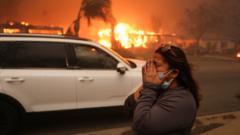Levels of carbon dioxide (CO2), the most significant greenhouse gas, soared to unprecedented heights in 2024, marking the fastest increase ever recorded, according to scientists. With CO2 concentrations now exceeding 50% above pre-industrial levels, alarming implications arise for efforts to curb climate change.
Following last year’s record fossil fuel emissions, the natural world struggled to mitigate the surge in CO2 due to adverse conditions such as wildfires and drought. This collective scenario has left the global climate target of limiting warming to 1.5C—a goal established by nearly 200 nations at the 2015 Paris Agreement—hanging by a thread.
Reports confirm that 2024 heralded the hottest year on record, achieving temperatures that eclipsed the critical 1.5C threshold for the first time in a single calendar year. The Met Office emphasizes that this rapid escalation in CO2 levels is "incompatible" with the Paris Agreement, effectively jeopardizing the global commitment to slow the climate crisis.
Experts highlight that the long-term increase in CO2 is primarily driven by human activities, including the burning of coal, oil, and natural gas, as well as widespread deforestation. Data from the Global Carbon Project reveals that fossil fuel emissions experienced further spikes in 2023, while the natural environment was unable to absorb the corresponding amount of CO2.
Compounding the issue, the El Niño phenomenon—characterized by warmer surface waters in the eastern Pacific—further diminished natural carbon sinks, adversely affecting the planet's ability to capture CO2. The consequences have been devastating; wildfires, particularly in areas not typically prone to such events, pumped additional CO2 into the atmosphere, exacerbating the climate issue.
A stark warning comes from Prof. Richard Betts of the Met Office, who stresses that the pace of CO2 rises is now outpacing the projections set forth by the Intergovernmental Panel on Climate Change (IPCC). Between 2023 and 2024, CO2 levels surged nearly 3.6 parts per million, reaching an all-time high of over 424ppm, based on measurements taken at the Mauna Loa research station in Hawaii since 1958. Prof. Ralph Keeling, leading the measurement program at the Scripps Institution of Oceanography, underscores the unprecedented speed at which we are venturing into uncharted territory.
Moreover, the amplified CO2 emissions paint a grim picture for the natural world's future capacity to absorb greenhouse gases. Recent findings from NOAA indicate a troubling trend in the Arctic tundra, which is transitioning to a net source of CO2, while regions like the Amazon rainforest face deteriorating absorption capabilities due to drought and deforestation.
Although predictions for 2025 suggest a potential moderation in the CO2 rise, concerns remain that the climate crisis is far from alleviating. Experts note that while La Niña conditions might facilitate temporary cooling and enhance CO2 absorption, the persistent accumulation of greenhouse gases means a return to warming is inevitable. Prof. Betts cautioned that while cooler temperatures could provide a temporary reprieve, they will not halt the ongoing challenges posed by rising atmospheric CO2 levels.
Following last year’s record fossil fuel emissions, the natural world struggled to mitigate the surge in CO2 due to adverse conditions such as wildfires and drought. This collective scenario has left the global climate target of limiting warming to 1.5C—a goal established by nearly 200 nations at the 2015 Paris Agreement—hanging by a thread.
Reports confirm that 2024 heralded the hottest year on record, achieving temperatures that eclipsed the critical 1.5C threshold for the first time in a single calendar year. The Met Office emphasizes that this rapid escalation in CO2 levels is "incompatible" with the Paris Agreement, effectively jeopardizing the global commitment to slow the climate crisis.
Experts highlight that the long-term increase in CO2 is primarily driven by human activities, including the burning of coal, oil, and natural gas, as well as widespread deforestation. Data from the Global Carbon Project reveals that fossil fuel emissions experienced further spikes in 2023, while the natural environment was unable to absorb the corresponding amount of CO2.
Compounding the issue, the El Niño phenomenon—characterized by warmer surface waters in the eastern Pacific—further diminished natural carbon sinks, adversely affecting the planet's ability to capture CO2. The consequences have been devastating; wildfires, particularly in areas not typically prone to such events, pumped additional CO2 into the atmosphere, exacerbating the climate issue.
A stark warning comes from Prof. Richard Betts of the Met Office, who stresses that the pace of CO2 rises is now outpacing the projections set forth by the Intergovernmental Panel on Climate Change (IPCC). Between 2023 and 2024, CO2 levels surged nearly 3.6 parts per million, reaching an all-time high of over 424ppm, based on measurements taken at the Mauna Loa research station in Hawaii since 1958. Prof. Ralph Keeling, leading the measurement program at the Scripps Institution of Oceanography, underscores the unprecedented speed at which we are venturing into uncharted territory.
Moreover, the amplified CO2 emissions paint a grim picture for the natural world's future capacity to absorb greenhouse gases. Recent findings from NOAA indicate a troubling trend in the Arctic tundra, which is transitioning to a net source of CO2, while regions like the Amazon rainforest face deteriorating absorption capabilities due to drought and deforestation.
Although predictions for 2025 suggest a potential moderation in the CO2 rise, concerns remain that the climate crisis is far from alleviating. Experts note that while La Niña conditions might facilitate temporary cooling and enhance CO2 absorption, the persistent accumulation of greenhouse gases means a return to warming is inevitable. Prof. Betts cautioned that while cooler temperatures could provide a temporary reprieve, they will not halt the ongoing challenges posed by rising atmospheric CO2 levels.





















